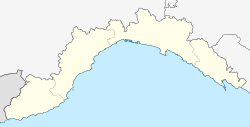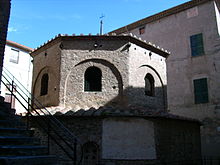
The Italian Riviera or Ligurian Riviera is the narrow coastal strip in Italy which lies between the Ligurian Sea and the mountain chain formed by the Maritime Alps and the Apennines. Longitudinally it extends from the border with France and the French Riviera near Ventimiglia eastwards to Capo Corvo which marks the eastern end of the Gulf of La Spezia and is close to the regional border between Liguria and Tuscany. The Italian Riviera thus includes nearly all of the coastline of Liguria. Historically the "Riviera" extended further to the west, through what is now French territory as far as Marseille.

Liguria is a region of north-western Italy; its capital is Genoa. Its territory is crossed by the Alps and the Apennines mountain range and is roughly coextensive with the former territory of the Republic of Genoa. Liguria is bordered by France to the west, Piedmont to the north, and Emilia-Romagna and Tuscany to the east. It rests on the Ligurian Sea, and has a population of 1,557,533. The region is part of the Alps–Mediterranean Euroregion.

Bobbio is a small town and comune in the province of Piacenza in Emilia-Romagna, northern Italy. It is located in the Trebbia River valley southwest of the town Piacenza. There is also an abbey and a diocese of the same name. Bobbio is the administrative center of the Unione Montana Valli Trebbia e Luretta. It is one of I Borghi più belli d'Italia.

The Ligures or Ligurians were an ancient people after whom Liguria, a region of present-day north-western Italy, is named.

Savona is a seaport and comune in the west part of the northern Italian region of Liguria, capital of the Province of Savona, in the Riviera di Ponente on the Mediterranean Sea. Savona is the main center of the Italian Riviera.
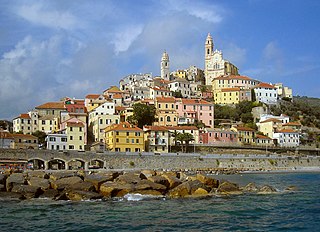
Cervo is a small, ancient town and comune, built on top of a hill along the Italian Riviera in the province of Imperia. It has approximately 1,200 inhabitants. It is one of I Borghi più belli d'Italia.
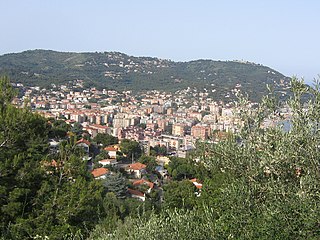
Andora or Marina di Andora is a town on the Italian Riviera in the region of Liguria, included in the province of Savona.

Arenzano is a coastal town and comune in the Metropolitan City of Genoa, Liguria, northern Italy, facing the Ligurian Sea. As of 2017, it has a population of 11,445. This varies during the holiday seasons due to tourist flow.

Civezza is a comune (municipality) in the Province of Imperia in the Italian region Liguria, located about 127 kilometres (79 mi) southwest of Genoa and about 7 kilometres (4 mi) west of Imperia. As of 31 December 2004, it had a population of 557 and an area of 3.8 square kilometres (1.5 sq mi).

Diano Marina is a comune (municipality) in the Province of Imperia in the Italian region of Liguria, located about 90 kilometres (56 mi) southwest of Genoa and about 5 kilometres (3.1 mi) northeast of Imperia.

Cairo Montenotte is a comune (municipality) in the Province of Savona in Liguria, an Italian region located 50 kilometres (31 mi) west of Genoa and 20 kilometres (12 mi) northwest of Savona. Located in Val Bormida, it is a member of the Comunità Montana Alta Val Bormida. It is considered to be the main centre of Val Bormida and it has 12691 inhabitants. It is the fourth municipality in the province together with Savona, Albenga and Varazze, as well as the most popular municipality in Liguria among those without outlet on the sea. The municipal area is the biggest in the province behind Sassello, and the fifth in Liguria.

Ceriale is a comune (municipality) in the Province of Savona in the Italian region of Liguria, located about 70 kilometres (43 mi) southwest of Genoa and about 30 kilometres (19 mi) southwest of Savona.

Moneglia is a comune (municipality) in the Metropolitan City of Genoa in the Italian region Liguria, located about 50 kilometres southeast of Genoa. It is a tourist resort on the Riviera di Levante. It is one of I Borghi più belli d'Italia.
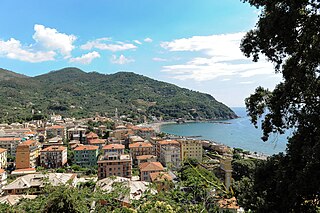
Levanto is a comune (municipality) in the province of La Spezia, in the Italian region of Liguria, located almost 90 kilometres (56 mi) southeast of Genoa and about 20 kilometres (12 mi) northwest of La Spezia.

Gallinara or Isola d'Albenga is a small private island that lies in the Ligurian Sea off the coast of Albenga in the Province of Savona, Liguria, northern Italy. It is known for its unique shape, resembling a turtle.

Albenga Cathedral is a Roman Catholic cathedral dedicated to Saint Michael in the city of Albenga, in the province of Savona and the region of Liguria, Italy. It is the seat of the Diocese of Albenga-Imperia.

Imperia is a coastal city and comune in the region of Liguria, Italy. It is the capital of the Province of Imperia, and historically it was capital of the Intemelia district of Liguria. Benito Mussolini created the city of Imperia on 21 October 1923 by combining Porto Maurizio and Oneglia, as well as the surrounding village communes of Piani, Caramagna Ligure, Castelvecchio di Santa Maria Maggiore, Borgo Sant'Agata, Costa d'Oneglia, Poggi, Torrazza, Moltedo and Montegrazie.
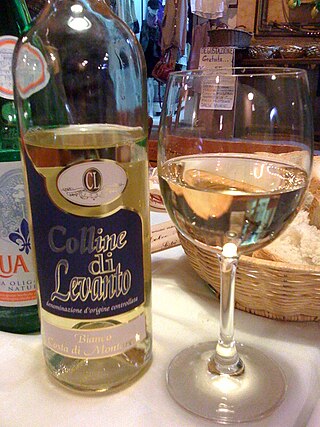
Liguria is an Italian wine region located in the northwest region of Italy along the Italian Riviera. It is bordered by the Piedmont wine region to the north, the Alps and French wine region of Provence to the west, the Apennine Mountains and the Emilia-Romagna wine region to the east with a small border shared with Tuscany in the south-east along the Ligurian sea.

The Centa is a very short Italian river in the province of Savona.
The Ingauni were a Celto-Ligurian tribe dwelling on the Mediterranean coast, around the modern city of Albenga (Liguria), during the Iron Age and the Roman period.




